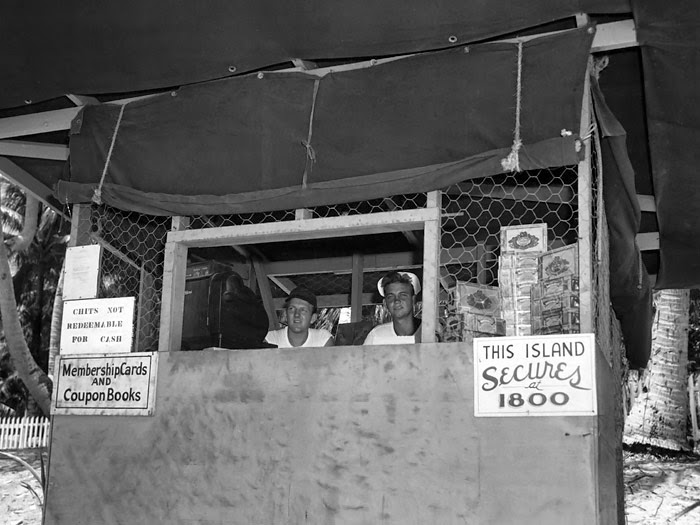 By all accounts, the biggest repair job for my dad's ship, USS Hector, at Ulithi—or anywhere throughout the war—came on this date in 1944. The cruiser, USS Houston, twice torpedoed by Japanese bombers, was towed alongside for repairs.
By all accounts, the biggest repair job for my dad's ship, USS Hector, at Ulithi—or anywhere throughout the war—came on this date in 1944. The cruiser, USS Houston, twice torpedoed by Japanese bombers, was towed alongside for repairs.
A couple of weeks earlier on October 14, USS Houston was attacked by Japanese torpedo planes off the coast of Formosa (known today as Taiwan), causing serious damage. Initially, the flooding was so severe that the crew was ordered to abandon ship. However, when further investigation showed that the ship might be saved, the commanding officer ordered all remaining personnel to stay on board. Two hours later the wounded Houston was under tow by the heavy cruiser, USS Boston.1
For the next 2 days, the remaining skeleton crew pumped water, shored bulkheads, and fought fires while their ship continued to settle further in the water. They also found some time to burry 2 men who died of fatal burns from the torpedo attack. More burials would follow.
On the 16th, the tugboat Pawnee took over towing Houston to Ulithi for repairs. That afternoon a second aerial torpedo hit the ship, killing 55 crewmen and wounding many more. However, despite the terrible human loss and further damage to the ship, Houston's heroic crew fought to keep the ship afloat.2 The brave men of the Pawnee also never wavered in their task. Amazingly, both ships managed to make it to Ulithi on this date where the Hector was waiting.
For the next 2 days, the remaining skeleton crew pumped water, shored bulkheads, and fought fires while their ship continued to settle further in the water. They also found some time to burry 2 men who died of fatal burns from the torpedo attack. More burials would follow.
On the 16th, the tugboat Pawnee took over towing Houston to Ulithi for repairs. That afternoon a second aerial torpedo hit the ship, killing 55 crewmen and wounding many more. However, despite the terrible human loss and further damage to the ship, Houston's heroic crew fought to keep the ship afloat.2 The brave men of the Pawnee also never wavered in their task. Amazingly, both ships managed to make it to Ulithi on this date where the Hector was waiting.
Initially, Hector's crews spent a great deal of time and effort in clearing away wreckage, welding up holes, pumping out water, washing up oil and fuel, and otherwise readying the ship for extensive repairs. During this stage, there also was the grim task of removing bodies. The remains of 30 victims had to be recovered from the lower, flooded parts of the ship.
Dad was among welding crews completed myriad repair jobs, including the installation of more than 2,000 feet of T-bar to stiffen and reinforce the main, second, and upper decks. Houston's girders and plating were strengthened, and equipment was salvaged and repaired. Steering control to the bridge was also restored.
 |
| Hector's repair crews tended Houston from October 27 to December 14, 1944 |
Although interrupted by enemy sub attacks3 on ships in the harbor and hampered by a severe typhoon season,4 Hector managed to repair Houston by December 14, in addition to work on many other smaller vessels.
Houston next was towed to Manus Island for further repairs, and then headed back to New York Navy Yard in March 1945. Her permanent repairs were completed as the war drew to a close. Houston remained in service until 1947, when she was decommissioned. In 1959, she was sold for scrap.
The valiant USS Houston received 3 battle stars for her World War II service.
 |
| The resurrected Houston in January 1945, following emergency repairs by Hector |
1 The cruiser, USS Birmingham, was another ship that came to Houston's aid after the attack. She acted as escort for the damaged ship and took on almost 200 crew members evacuated from Houston. Birmingham will again come to the aid of another critically damaged ship in the Battle of Leyte Gulf. However, tragically, on October 24th, Birmingham suffered extensive damage in the rescue attempt, and received 200 casualties among her crew.
2 Houston's War Diary for October 1944 is fascinating for its detail and description of the 14-day ordeal on the stricken ship.
2 Houston's War Diary for October 1944 is fascinating for its detail and description of the 14-day ordeal on the stricken ship.
3 On November 20, 1944, the Ulithi harbor was attacked by Japanese human torpedoes (kaitens) launched from 2 nearby submarines. The fleet oiler, Mississinewa, was struck and sunk. Guns were manned, and boats from Houston and Hector patrolled the water around these vessels. No contact was made, but sailors witnessed 2 underwater explosions in the atoll.
4 On November 5, Hector towed Houston to the southern part of the harbor near Pig Island for shallow water anchorage during the typhoon that hit from the 6th to the 8th. Wind and rough water caused additional damage to the ship. Houston remained there through the end of the month.
Sources: USS Houston War Diary, October-December 1944; USS Hector War Diary, October-December, 1944; USS Hector AR7- Ship’s Log (WWII); Dictionary of American Naval Fighting Ships; Naval Historical Center


















